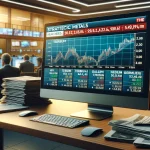
Weekly News Review June 2 – June 8 2025
June 8, 2025
Weekly News Review June 16 – June 22 2025
June 22, 2025Once again, rare earths dominated the headlines this week. Industry leader China released the latest trade data for this group of raw materials, which is partly subject to strict export controls. For the U.S. market, a loosening of these restrictions could be on the horizon.
All this and more from the newsroom in our weekly global round-up.
CHINA: RARE EARTH EXPORTS DECLINE IN MAY –
China’s General Administration of Customs released preliminary trade data for May, revealing a significant drop in the value of rare earth element exports. The total export value decreased by over 47% year-over-year, with a month-over-month decline of approximately 14% compared to the previous month.
Although higher than in April, export volumes declined year-on-year in May, with 5,864.6 tonnes shipped, representing a decrease of approximately 5.7% compared to the same month in 2024. Nevertheless, total rare earth exports from January to May reached 24,827 tonnes, reflecting a 2.3% year-over-year increase in volume.
The data includes exports of all 17 rare earth elements, not only the seven Beijing imposed export controls on in early April. More detailed information regarding how individual elements are developing will be available once Beijing publishes the second batch of May export data later this month.
Meanwhile, U.S.-China trade talks are set to continue in London on Tuesday, with export controls expected to be among the core issues. While Beijing has recently announced the easing of some measures introduced in response to the Trump-era trade tariffs, the rare earth export controls remain in place so far. In a commentary published in the state-affiliated newspaper Global Times, Huo Jianguo, the former president of China’s Ministry of Commerce research institute, argues that the issue can only be resolved through mutual respect, openness, and lawful conduct.
PLATINUM RISES TO FOUR-YEAR HIGH:
Platinum prices have surged to their highest levels since May 2021, even outpacing gold in year-to-date performance. So far, platinum has risen 32% over the last 12 months, compared to gold’s 26% gain. According to Philipp Götzl-Mamba, a precious metals expert at German raw materials trader TRADIUM, the rally is supported by multiple overlapping factors. Persistent supply constraints in South Africa, the world’s leading platinum producer, coupled with strong demand, especially in the jewelry sector, are key contributors.
Here, platinum is increasingly seen as an alternative to gold following its record-breaking rally and elevated prices. In addition, platinum’s apparent undervaluation relative to gold is fueling further momentum. A similar metric, the gold-silver ratio, has propelled silver over the last week to a 13-year high.
On the supply side, the World Platinum Investment Council (WPIC) forecasts a market deficit of almost 1 million ounces in 2025, the most significant shortfall in years .
Meanwhile, demand from the financial sector is also on the rise, with holdings in platinum-backed exchange-traded funds (ETFs) reaching a 10-month high, according to Bloomberg, signaling increased participation from institutional investors.
EUROPE: CLOSER COOPERATION BETWEEN FRANCE AND ARGENTINA ANNOUNCED –
The Presidents of Argentina and France are aiming to strengthen cooperation on critical raw materials. On the sidelines of the UN Ocean Conference in Nice, Argentina’s Javier Milei and France’s Emmanuel Macron discussed a potential bilateral agreement focused on the development of critical minerals, according to the Buenos Aires Times.
The deal would encourage French investment and financial support for lithium and copper extraction in Argentina, as well as joint research projects to explore new mineral deposits. Nuclear energy was also on the agenda, with France positioning itself as a partner for Argentina’s atomic expansion, reports the Argentine newspaper Perfil.
The long-delayed free trade agreement between the Mercosur bloc (Argentina, Brazil, Paraguay, and Uruguay) and the European Union was another key topic of discussion in Nice. While the deal could significantly improve Europe’s access to vital raw materials, it faces resistance, particularly in France, where farmers are concerned about competition from lower-cost agricultural imports from South America. Still, with some adjustments, the agreement could be signed before the end of the year, Perfil adds.
UNITED STATES AND CHINA MOVE CLOSER ON RARE EARTHS?
The People’s Republic may ease its export restrictions after the two countries reached a framework agreement in their ongoing trade dispute. The impact on other countries remains unclear.
Will China soon resume larger shipments of rare earths and magnets to the U.S.? Although the export restrictions imposed in early April apply globally and have already caused production disruptions, the situation may ease—at least in the U.S. market. According to media reports, government representatives from both countries agreed on Tuesday to relax these trade restrictions.
In return, the U.S. is expected to lift some of its export controls on certain strategic goods and software, which had been imposed in response. The agreement was reached after two days of negotiations in London.
The talks were preceded by a meeting in Geneva last month, at which both parties agreed to reduce their mutual punitive tariffs temporarily. However, reports indicate that disagreements remained on several key issues. From the U.S. perspective, the lifting of China’s rare earth restrictions was part of the Geneva deal. When exports in this product category remained heavily limited, the U.S. responded with the measures above.
A rare phone call between Presidents Donald Trump and Xi Jinping later paved the way for the recent agreement in London. The proposal will now be submitted to both leaders for final approval, U.S. Commerce Secretary Howard Lutnick told reporters. A more comprehensive agreement is to be negotiated by August 10.
Shortly after the conclusion of the London negotiations, Chinese rare earth magnet producer JL Mag Rare-Earth announced it had received export licenses for shipments to the U.S., among others—something Bloomberg interpreted as a possible sign of easing tensions between Beijing and Washington.
No Sign of a Fundamental Resolution to the Trade Conflict:
According to Reuters, however, there are no indications of a lasting resolution to the long-running trade conflict. In this context, the U.S. had already restricted China’s access to advanced chip technology in 2022.
One of the more recent escalations in the trade war was China’s explicit export ban on critical minerals, such as gallium and germanium, to the U.S. Like rare earths; these metals are predominantly produced in China and play an essential role in both civilian and military applications.
As the world pivots from oil to metals, rare earths have become the frontline in geo-political decisions.






